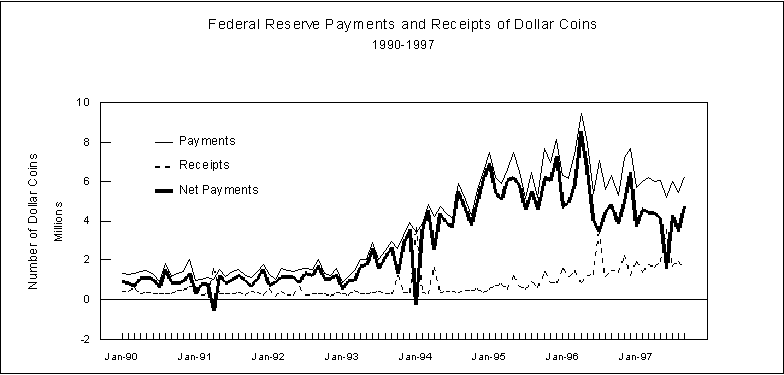

|
Testimony of Theodore Allison Assistant to the Board for Federal Reserve System Affairs H.R. 2637, the United States $1 Coin Act of 1997 Before the Subcommittee on Domestic and International Monetary Policy of the Committee on Banking and Financial Services, U.S. House of Representatives October 21, 1997 |
|
Thank you for the opportunity to comment on H.R. 2637, the United States $1 Coin Act of 1997. Under H.R. 2637, the dollar coin would be made gold in color and would be given a distinctive rim; it would retain the dimensions of the Susan B. Anthony dollar coin; and the dollar note would remain in circulation. The Federal Reserve believes that H.R. 2637 achieves a good balance among the issues involved in the dollar-coin-versus-dollar-note debate and supports its passage. For most of this decade, there has been a public discussion of the merits of replacing the dollar note with a dollar coin, with no consensus having developed in favor of doing so. Out of this discussion, however, a few conclusions can be drawn:
In the meantime, there has been an ongoing demand for Susan B. Anthony coins, with the result that the combined inventory at the Mint and the Federal Reserve, which now stands at about 133 million coins, will be depleted during the first half of the year 2000 assuming continuation of the current rate of withdrawals from Federal Reserve Banks, which is averaging about 4.2 million coins per month. (Data on dollar-coin payments and receipts at Reserve Banks are presented in Figure 1.) Thus, it is likely that the Treasury Department will need to produce more dollar coins of some kind within the next several years. Even if the rate of withdrawals were to decline moderately in the next few years, as it has over the last several, the existing stock of dollar coins would likely be exhausted within a period that makes it advisable to plan now for that event. |
|
|
| Figure 1 |
|
Public reaction to the design of the Susan B. Anthony dollar has been negative from the beginning. In 1978, even before the coin was issued, research conducted for the Federal Reserve by the University of Michigan business school, using focus group interviews with both consumers and retailers, revealed considerable reservations in both groups about the Anthony design. The main concern was the perceived similarity to the quarter and, as a consequence, the risk of making a mistake in handling change. Through the years since, potential confusion with the quarter has dominated the public's perception of the dollar coin. Thus, it would not seem considerate--either of the public who dislike the Anthony dollar or of the merchants who need a viable dollar coin--if the impending depletion of Anthony dollars were addressed by manufacturing more of those coins. Nor would it seem appropriate to introduce a new dollar coin with dimensions markedly different from those of the Anthony dollar since that would require that nearly all vending machines be mechanically refitted at considerable cost to the vending machine industry and its customers. Moreover, a decision to withdraw the dollar note in connection with issuance of a redesigned dollar coin would be contrary to the preference of most Americans, who apparently do not wish at this time to give up the note. Enactment of H.R. 2637 would address all of these issues in a way that should be consistent with the needs of most of the affected public: The gold color and distinctive rim of the newly designed coin should make the public more approving of it than it now is of the Susan B. Anthony dollar. That in turn should benefit vending machine operators and other merchants who wish to see greater use of a dollar coin. Maintaining the Anthony dollar's dimensions in the new coin should minimize the introduction costs that vending machine operators would face. And retention of the dollar note would be consistent with the apparent wishes of most individuals at this time. Finally, I should observe that the Treasury of the United States--and thereby taxpayers--would benefit financially if, and to the extent that, the availability of a more acceptable dollar coin either caused dollar coins to substitute for dollar notes in circulation more than would be the case without it or caused the total circulation of dollar notes and dollar coins to increase further than would have been the case otherwise.1 Although this effect may not be large, it should be positive. |
|
Footnote 1 The impact of substituting dollar coins for dollar notes on the Treasury's financial position has been outlined in previous Board statements to the Congress. (See, for example, Statement by Edward W. Kelley, Jr., Member, Board of Governors of the Federal Reserve System, to the Subcommittee on Domestic and International Monetary Policy of the Committee on Banking and Financial Services, U.S. House of Representatives, May 3, 1995, Federal Reserve Bulletin, July 1995, pp. 676-78.) |